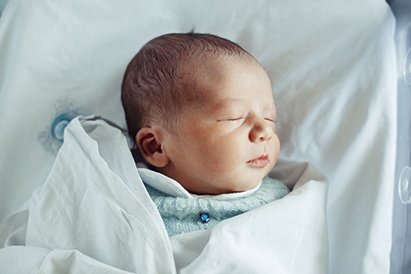 As the parent of a newborn, you will do almost anything to get your baby to sleep. Especially when you are over tired. There is lots of advice on getting your baby to sleep. Much of it can be confusing and conflicting. One thing that you should never compromise on – a safe sleep environment.
As the parent of a newborn, you will do almost anything to get your baby to sleep. Especially when you are over tired. There is lots of advice on getting your baby to sleep. Much of it can be confusing and conflicting. One thing that you should never compromise on – a safe sleep environment.
A Cool Crib is a Safe Crib
First make sure your infant has a safe crib to sleep in. Check to make sure your crib meets the safety standards of the Consumer Product Safety Commission (CPSC) and the Juvenile Products Manufacturers Association (JPMA). Confirm that the crib has all of the pieces. Do not use drop side cribs or cribs that have design cutouts in the head or foot boards. Stuffed animals, pillows, bumper pads and other accessories should not be used in the crib. These pose a suffocation hazard to small children. A firm mattress covered with a tight-fitting crib sheet is all your baby needs.
Have your baby sleep in their own crib in or near your room until the age of 6 months. This helps reduce the risk of Sudden Infant Death Syndrome (SIDS), and makes it more convenient for you. Be sure that to return him/her to their own crib after each feeding or diaper change. Avoid placing the crib near windows, draperies or blinds. Don’t hang anything with a cord or string above your baby’s bed.
Back To Sleep
Make sure you are laying your baby down to sleep on their back. This guideline has been out since 1993, when the American Academy of Pediatrics began recommending that babies sleep on their backs, For many, this may be different than the old practice of placing your infant on their tummy. However, because of the “back to sleep” guidelines published in 1993, the SIDS death rate has dropped by more than 50%.
What to Wear
In general, it is best to dress your baby in one layer of clothing more than you are comfortable wearing. If the room feels comfortable for you, then it is most likely comfortable for your baby. If you’re worried about keeping them warm on an especially cold night, try using a sleep sack or wearable blanket rather than a loose blanket.
Babies should not sleep on beds, sofas, recliners, chairs, soft surfaces, bouncy chairs, baby swings or car seats. If they fall asleep in these places, move them to a safe sleep environment as soon as possible.
Following these tips can help you keep your baby safe while they sleep and can help give you peace of mind so that you can get some rest too.
Search Our Blog
Our Instagram
Recent Posts
- 10 Tips to Help Parents Improve Their Child’s Speech May 3, 2017
- “I Know it Couldn’t Have Been Easy to Say “Yes” to Organ Donation, but it Changed Our Lives” April 24, 2017
- Don’t Lose Those Pearly Whites - Teeth Safety Tips for Your Little Athletes April 21, 2017
- A Home Away from Home While Staying at Primary Children’s Hospital April 18, 2017
- In Her Own Words: A 12-Year-Old’s Story of a Failing Heart and Life-Saving Transplant April 7, 2017
Our Most Popular Posts
- 10 Tips to Help Parents Improve Their Child’s Speech 137 views
 5 Acupressure Points Every Parent Should Know 21 views
5 Acupressure Points Every Parent Should Know 21 views  “We Have Seen Many Miracles . . . ” the Healing Journey for a Baby With Omphalocele 9 views
“We Have Seen Many Miracles . . . ” the Healing Journey for a Baby With Omphalocele 9 views  Street Safety: 10 Pedestrian Safety Tips for Kids 9 views
Street Safety: 10 Pedestrian Safety Tips for Kids 9 views - “I Know it Couldn’t Have Been Easy to Say “Yes” to Organ Donation, but it Changed Our Lives” 5 views
- In Her Own Words: A 12-Year-Old’s Story of a Failing Heart and Life-Saving Transplant 4 views
- Take a Hike! 6 Tips to Ensure Safe Family Hiking 4 views
 Celebrating the First X-Ray and Radiology’s Contributions to Children’s Health Care 2 views
Celebrating the First X-Ray and Radiology’s Contributions to Children’s Health Care 2 views  Children with Trisomy 13 and 18 attend special Primary Children’s clinic 2 views
Children with Trisomy 13 and 18 attend special Primary Children’s clinic 2 views - How to Help Your Teen Avoid Substance Abuse 2 views
Archives
- May 2017 (1)
- April 2017 (5)
- March 2017 (3)
- February 2017 (2)
- January 2017 (1)
- December 2016 (3)
- November 2016 (1)
- October 2016 (5)
- September 2016 (4)
- August 2016 (6)
- July 2016 (4)
- June 2016 (4)
- May 2016 (1)
- April 2016 (3)
- March 2016 (5)
- February 2016 (6)
- January 2016 (7)
- December 2015 (5)
- November 2015 (8)
- October 2015 (8)
- September 2015 (2)
- August 2015 (1)
- July 2015 (3)
- June 2015 (2)
- May 2015 (2)
- March 2015 (3)
- February 2015 (2)
- January 2015 (2)
- November 2014 (1)
- October 2014 (1)
- September 2014 (3)
- August 2014 (2)
- July 2014 (4)
- June 2014 (2)
- May 2014 (4)
- April 2014 (6)
- March 2014 (4)
- February 2014 (1)
- September 2013 (1)
- February 2013 (1)
- June 2012 (1)















Add comment